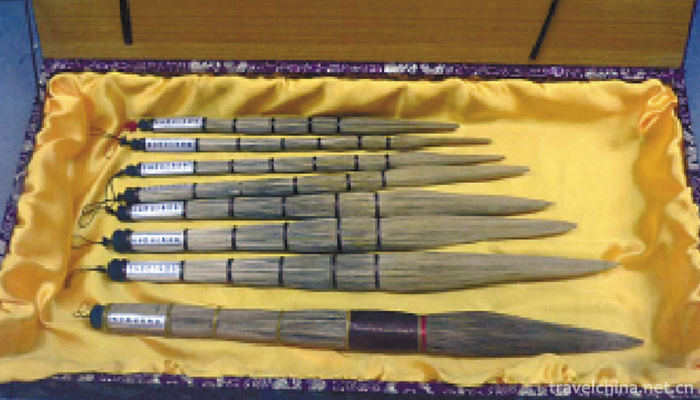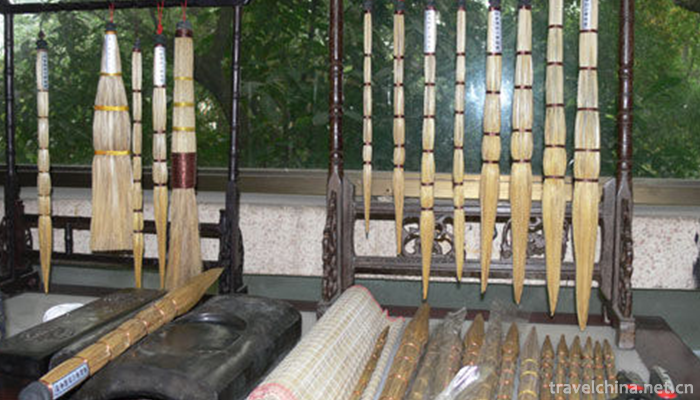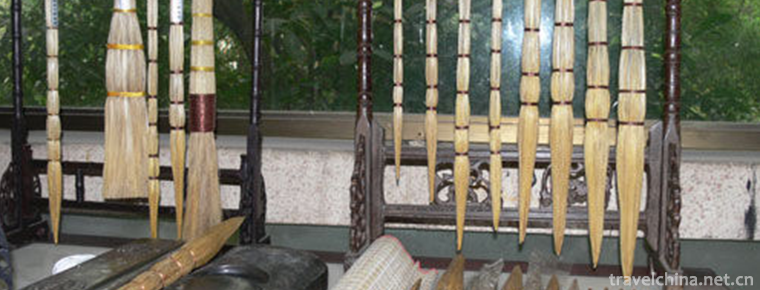Dragon Pen Making Skills of White Shamao
Dragon Pen Making Skills of White Shamao
The craftsmanship of the Dragon pen of Baishamao was originated by Chen Baisha, a famous calligrapher. It has a history of more than 500 years. Made of Maotao, a special product of Guifeng Mountain, Xinhui, it has the characteristics of moderate hardness, good ink absorption, elasticity, fluent writing and durability. Especially because there is no pen tip, there are gaps in the strokes when swinging, forming a unique "flying white".
In June 2008, it was selected as the second batch of national intangible cultural heritage list approved by the Ministry of Culture by the State Council.
historical origin
In June 2008, it was selected as the second batch of national intangible cultural heritage list approved by the Ministry of Culture by the State Council.
White Shamao Dragon Pen originated in the Ming Dynasty and has a history of more than 500 years. The founder was Mr. Chen Baisha (Chen Xianzhang), an agent, poet and calligrapher of the Ming Dynasty. It is a Jiangmen specialty made of thatch.
Mao Longbi is a famous special product of the New Congress. It sells well all over the country and enjoys a good reputation in Southeast Asia. Its inventor is Mr. Chen Baisha, a Guangdong scholar. Mr. Baisha made a crayon from white grass on Guifeng Mountain of Xinhui. His calligraphy was vigorous and vigorous. At that time, it was well known all over the country and had a far-reaching influence and was known as "one person in Lingnan". Mr. Baisha has a deep feeling for Mao Longbi, which he respectfully calls Mao Jun. In his poems, there are poems praising the magic of Mao Longbi: "Mao Jun takes a little action and starts to call God Gong". In his old age, he couldn't write with a crayon. He said with a general sigh, "Thank Maojun for his long life, and be quiet until the end."
Mr. Baisha has left behind many calligraphic handwriting, such as "Ciyuan Temple Stele" (stone inscriptions), the "endurance" word praise (wood inscriptions), and "planting Ramie" (paper handscrolls, cursive scripts) and so on.
Hundreds of years have passed, and the folk stunt of forming a dragon pen from a grass in Guifeng is still spreading on the land of overseas Chinese. Nowadays, not only in China, but also in Japan, Southeast Asia and other countries, many foreign friends even come to Jiangmen to visit folk artists who make Mao Longbi.
Mao Long's calligraphy is unique and weak since the Yuan Dynasty. However, while people appreciate the artistic charm of Mao Long's calligraphy, they have never thought that Mao Long's brushes are all completed manually from material picking to writing. For hundreds of years, the production skills of Mao Longbi have been mastered by the words and deeds of teachers and apprentices, and by personal long-term understanding and practical exploration. With the change of the times, there are fewer and fewer workshops for folk production of Mao Longbi, and the inheritance of this folk stunt has become the focus of attention.
"Guangdong Xinyu" has a "Mao Bi" article: "Baisha likes to use a Mao Bi, living in Guifeng, whose Mao Duosheng stone, white and vigorous, with the shackles of Mao Xin as the pen, writing more simple and wild. According to legend, when Mr. Baisha was lecturing at Guifeng Mountain, he said that "living in the mountains is bitter without pen". One autumn evening that year, he sat reading on a big stone in front of Yutai Temple in Guifeng Mountain. Suddenly, a piece of white thatch on the stone was green and lovely, so he reached out and tried to break one, but it took a lot of effort to break it. He looked closely at the fracture near the roots of the thatch and revealed a bunch of soft and elastic white hair, which was very similar to the writing brush. He was so happy that he immediately picked a handful of white grass and went home. The next day he took it out for drying. He smashed it lightly with a wooden birch and soaked it in the ash water for several hours. After bagging, he dried it and tied it into a bunch of pens. He dipped his pen in ink and absorbed it well; he wrote a "pen" with a strong, vivid and masculine strokes. Mr. Baisha was so happy that he was nicknamed "Mao Long Bi". Since then, Mr. Baisha has created Mao Long's calligraphy with Mao Long's pen, which is famous both at home and abroad.
Skill inheritance
In the 1970s, Zhang Ruiheng's craftsmanship, which used to make crayons in Xinhui Craft Works, was much the same as Zhang Ruiheng's.
Mao Longbi is tough and hard to handle. Its service life ranges from 2 to 20 years. Those who buy Mao Longbi are acquaintances or famous artists. Generally, those who are new to painting and calligraphy do not use Mao Longbi. Mao Longbi is generally more expensive than brush.
Uncle Nie, Zhang Ruiheng and other artists do not make a living as crayons. "Everyone who has ever worked as a crayon knows that it's hard to make money selling crayons." Uncle Nie and others said that nowadays, Maolong has become a hobby. "You can't rely on it for food."
Behind the optimism, many artists have also raised three practical problems encountered by Mao Longbi: firstly, Mao Longbi has always been made by folk artists. For a long time, the production skills of Mao Longbi have been handed down from generation to generation by teachers and apprentices, and can be mastered only by personal long-term understanding and practice, exploration, experience and feeling, without specific research records; secondly, Mao Longbi production takes time. It takes a lot of work to pick grass on the hill, and the production process is trivial and mediocre. Most young people are unwilling to learn. Thirdly, Mao Longbi has a long production process, low manual efficiency and high cost. Only four or five people in Wuyi are engaged in Mao Longbi production, and its sales are very small, so it is difficult to promote it.
But this seemingly hands-on invention is not an occasional wild interest, but the self-confidence and self-consciousness of his cultural creation. This spirit in the blood of Lingnan is much more precious than the specific pen he left behind. In this way, the loss of his pen-making skills is not so regrettable, besides, the new craftsmanship of Mao Longbi is in the ascendant. The intangible cultural heritage is the treasure of our traditional culture and is a kind of "living" culture. There are 22 intangible cultural heritages successfully approved by Xinhui District, including three national-level ones, Xinhui Kuiyi, Baishamao Longbi and Cai Li Foquan. At the provincial level, there are Xinhui Kuiyi, Baishamao Longbi, Cai Li Foquan, Chen Pi's production skills, Yamen sea battle spreading stories and Chen Mengji's stories. There are 8 items in Shimbun, Kooka's craftsmanship in making classical furniture and Xinhui's craftsmanship in making classical furniture. At the same time, the New Society has established such inheritance bases as Cai Li Fohong's Sacred Archives Hall, Xinhui Kuibo Garden, Mao Longbi Museum of Gangzhou Painting Academy, Xinhui Classical Furniture Expo Center, Chen Pi Village, Xinhui Senior Technician School and so on. Regular activities and training courses for inheritors are held to ensure better inheritance of non-heritage projects.
Mao Longbi History
It is reported that Baishamao Longbi was created by Chen Baisha, a great scholar in Lingnan in the Ming Dynasty. It has been more than 500 years since its production technology was appraised as a national intangible cultural heritage. Mao Longbi's calligraphy has the characteristics of "vigorous, vigorous, vigorous, hard and vivid, flying white" and shows a strong, magnificent and masculine atmosphere.
In terms of cultural tourism, Jiangmen has rich and unique resources advantages. According to the person in charge of Jiangmen Culture, Radio, Television, Press and Publication Bureau, as early as 2007, Kaiping Diaolou and villages became the first world cultural heritage of Guangdong Province; in 2013, the archives approved by overseas Chinese became the first World Memory Heritage of Guangdong Province; in addition, Kaiping Diaolou and Liang Qichao's former residence were the key cultural relics protection units in the country, and seven folk arts, such as the craftsmanship of Baishamao Longbi and Hetang Yalong, were introduced. Art and folk art have been listed in the national intangible cultural heritage list. "The influence of festivals such as Jiangmen Overseas Chinese Carnival and Overseas Chinese Travel Festival is also increasing day by day."
Skill culture
The Festival is rich and colorful, including China Jade and Wonderful Stone Ornamental Exhibition, Stone Art Creative Competition and Guangdong Folk Stone Crafts Exhibition, Guangdong Arts and Crafts Master Works Exhibition, and "Stone Art Ancient Rhyme" Photography Competition Exhibition. Among them, the main exhibition hall of China Jade and Wonderful Stone Exhibition covers an area of 12,000 square meters, with 380 exhibition booths. 298 enterprises from Hong Kong, Taiwan, Guangdong, Guangxi, Yunnan, Hunan, Guizhou and other places participated in the exhibition. The exquisite stone art in the exhibition is rich in varieties, including all kinds of jade, stone carving, stone handicraft, end inkstone, ornamental stone, exotic stone, garden stone, root carving, crystal, agate, jewelry and other arts and crafts related to stone.
The Memorial Hall covers an area of 18,000 square meters, with a total building area of about 3800 square meters. It is a courtyard-style Memorial Hall for historical celebrities, which mainly protects the ancient buildings of the Ming Dynasty.
The main axis of the museum is the Baisha Temple and Mushi Archway built in the Ming Dynasty (the key cultural relics protection unit in Guangdong Province). In front of it is the newly built archway of Mr. Baisha's Bronze Statue Square and Chen Baisha Memorial Hall. The area of land used in the archway is surrounded by fences. On the East and west sides of Baisha Temple, there are calligraphy galleries and stele galleries, as well as garden-style buildings such as Huaisha Pavilion, lecture pavilion, literature pavilion, Jiahui Building, tourism service department, lotus pond and Panchi. In order to promote Mr. Baisha's tea culture, there are tea art galleries on both sides to facilitate leisure tea tasting.
On the east side of Baisha Temple, there are three exhibition areas in Chen Baisha's exhibition room, which exhibit Chen Baisha's deeds and ink cards all year round. About 50 meters from the northeast corner of Baisha Temple, is a tomb built in the Ming Dynasty Hongzhi Decade (1497) for Chen Baisha's parents. The tombstone, Mr. Baisha, was written in Mao Longbi. Pines and cypresses are evergreen all around.
On the west side of Baisha Temple, some old dwellings in Baisha's hometown have been preserved. The furniture in the dwellings is arranged according to the folk customs and features, and a folk exhibition area has been opened for tourists to visit. At the north end of Baisha's hometown, there are Xiaolu Mountain Stele Pavilion and Viewing Gallery. Green grass, bamboo shadow, has become a popular historical and cultural attraction in Jiangmen.
Skill honors
The second round was attended by 12 teams from 11 Higher Vocational Colleges in the Pearl River Delta region. The dance "Brush, ink, dragon and Guangdong" organized and created by Jiangmen Vocational College won the affirmation of the audience, the participating teams and the judges with its unique bright spots, characteristics, graceful dancing posture and positive spiritual outlook. It won the first prize in the competition area and won the competition with the participating teams of Shenzhen Vocational and Technical College. Two places in the final.
"Brush, ink, dragon and Guangdong" is a classical dance with the theme of Baishamao Dragon Pen, a national intangible cultural heritage of Jiangmen City. It shows the unique characteristics of Mao Dragon Pen in overseas Chinese's hometown. It is free and meaningful. Jiangmen Vocational College contestants hold the crayon pen, compose the rhyme actuation rate, and show their profound history and culture and enduring charm.
The Story of Chen Baisha and Mao Longbi
About a month has passed since the first activity of Baisha Lecture School. Many people are looking forward to the second lesson. The Baisha Lecture School opened its lecture at the Green Peach Protection Resort in Guifeng Mountain. The activities were supported by the public and tourists. This topic is "Chen Baisha and Mao Longbi". Teacher Chen Fushu, a famous calligrapher, is invited to give the lecture.
As we all know, the green peach protection source of Guifeng Mountain is the place where Mr. Chen Baisha read and lectured when he was young, and also the birthplace of Mao Longbi, the national intangible cultural heritage. The theme of "Chen Baisha and Mao Longbi" has been skillfully integrated here and given special significance. Mr. Chen Fushu has a deep foundation in calligraphy, and has his own unique views on Mr. Chen Baisha and Mao Longbi. At the beginning of the lecture, Mr. Chen talked about many allusions of Mr. Chen Baisha and Mao Longbi. Surrounded by the beautiful scenery of Green Peach Tree Garden, his lively, humorous and witty language makes the children and children on the scene indulge in it.
Of course, it's impossible to talk without practice. Mr. Chen gave a live exhibition of Mao Longbi calligraphy. Many calligraphy enthusiasts come forward to discuss with Mr. Chen. The children present were deeply impressed by the charm of Chinese culture, and their praise continued. On the eve of Children's Day, Mr. Chen encouraged children to study hard and write boldly. Teacher Chen improvised, but also increased the scene of calligraphy competition link, children enthusiastically participate, high mood. "Class is very happy, you can hear a lot of stories and knowledge, I also wrote a word under the guidance of the teacher, to collect well." The pupil Yiyi told the reporter happily.



-
1.Duck blood soup with vermicelli
Duck blood vermicelli soup is a famous specialty in Nanjing, belonging to Jinling food...
Time 2018-10-26 -
2.Yunpu Dongtian Tourist Area
Yimeng Yunpu Cave Tianshan Scenic Area is located in Feixian County, Shandong Province. There are five scenic spots: Tour Stone, Tianmeng Lake, Drunken Stone Forest
Time 2018-12-22 -
3.Zengjiashan Scenic Area
Zengjiashan Scenic Spot is located in Chaotian District of Guangyuan City, south foot of Qinba and the combination of Sichuan and Shaanxi. It covers 6 townships and townships with 70,000 people
Time 2019-01-04 -
4.West Mountain Scenic Spot of Guiping
Guiping Xishan Scenic Spot, National AAAA Scenic Spot, National Geopark. Located in Guiping City, southeastern Guangxi Zhuang Autonomous Region, Xishan Scenic Spots 1 km away from the outskirts of the
Time 2019-01-13 -
5.Huguangyan Scenic Spot
Huguangyan Scenic Spot is located 18 kilometers southwest of Zhanjiang City, the southernmost part of the mainland of China. It is called "natural yearbook" of earth and geological science b
Time 2019-01-16 -
6.Jinxiangshan Paradise
Jinxiang Mountain Scenic Spot in Jinan, Shandong Province, is located in the southern mountainous area of Jinan. It is endowed with unique topography, landform and rich forest resources
Time 2019-01-29 -
7.Bamboo Sea Scenic Spot in Southern Sichuan
The bamboo sea in southern Shunan, formerly known as Wanlingqing, is located in the remnants of the southern Tianshan Mountains adjacent to Yibin
Time 2019-02-08 -
8.Ansai waist drum
Ansai waist drum is a traditional folk dance in Shaanxi Province. Performances can be performed by several people or thousands of people together, magnificent momentum, exquisite performance is intoxi
Time 2019-03-31 -
9.Tongzhou Bangzi
Tongzhou Bangzi originated in more than ten counties of Dali (Gutongzhou) Center in the east of Guanzhong, Shaanxi Province. Accompanied instruments, besides drum beating, are also named for their str
Time 2019-06-21 -
10.Wuzuquan
Wuzu Quan is one of the Nanquan in traditional Chinese boxing. It is said that Cai Yuming (from Quanzhou, Fujian Province, 1853-1910) synthesized Baihe Quan, Monkey Quan, Arhat Quan, Dazun Quan and Ta
Time 2019-06-29 -
11.Huainan Normal University
The school was founded in 1958 when it was a teacher's College in Huainan. In 2000, approved by the Ministry of education, the former Huainan normal school, Huainan Education Institute and Huainan nor
Time 2019-11-16 -
12.Administrative division of Dazhou
In 1950, Daxian district was set up, which belongs to the northern Sichuan administrative region. Daxian special office is located in Daxian county and governs eight counties, including Daxian County, Xuanhan County, Kaijiang County, Pingchang
Time 2020-12-20